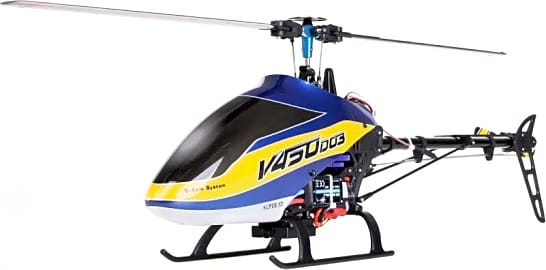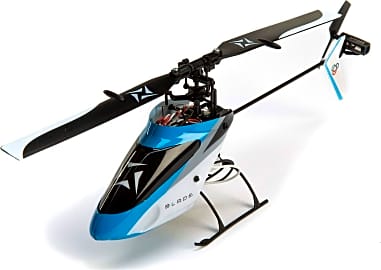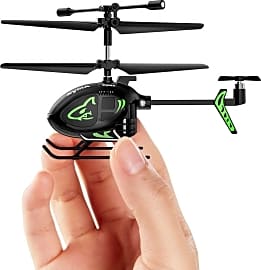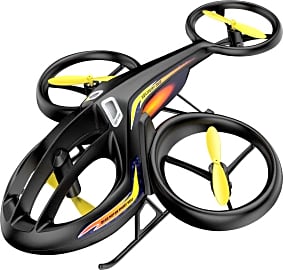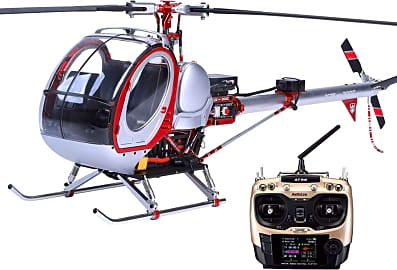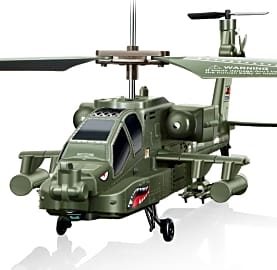The 8 Best RC Helicopters

This wiki has been updated 44 times since it was first published in March of 2015. The precursors to today's fancy drones, remote control helicopters deliver a challenge as well as a lot of fun for kids and adults alike. We've compiled a list of models in various sizes and suitable for varying skill levels, with some great for learning RC basics, some for performing advanced tricks, and everything in between. Be sure to follow all federal, state, and local laws when flying. When users buy our independently chosen editorial selections, we may earn commissions to help fund the Wiki.
Editor's Notes
May 07, 2021:
As usually happens with remote controlled vehicles, we had to replace a decent number of discontinued models we previously recommended. Additionally, we removed an Align kit body because you'd have to spend the price of the chopper all over again to get it running, and we eliminated a nitromethane-powered option because such fuel is unpleasant and somewhat dangerous to work with.
Luckily, there are plenty of great choices to fill in for what we've removed. Our new number 1, the WLToys XK K130 offers impressive overall performance and really shines in the agility department, making it ideal for performing tricks. The Blade Nano S3 is another compact model from a respected manufacturer, as is the Syma S107H-E, which is an excellent choice for beginners. Then there's a novel model called the Syma S100, which is about as small as they come and probably the best choice for indoor flying.
With all that said, we want to issue a final warning to make sure you're always obeying all relevant laws in terms of unmanned aerial vehicles in general, as well as privacy laws and restricted airspace.
January 08, 2020:
Partway between a model helicopter and a modern drone, RC helicopters have had a huge following for many years. We elected to stick with options that are almost completely ready to fly, minimizing the amount of assembly you'll have to do. The Vatos S880 is inexpensive and small, and suitable for indoor as well as outdoor flight, making it a good choice for beginners. Also great for beginners is the Syma S107H, which isn't very expensive -- neither are the Syma S109G or Syma S39, and they're both good upgrades in stability as well as size.
Speaking of size, one of the interesting things about the hobby is how large and powerful some of the models are. Unlike their reliable yet relatively tiny Blade MCX2, the Blade 230S V2 is a great all-around performer and one of the best large ones to run on battery power. The Align T-Rex 700X Kit is similarly large and uses a high-powered combustion engine that runs on pure nitromethane fuel, so while it has a significantly longer flight time than many others, it also requires a bit more experience to get running as well as to keep in perfect working order. The Walkera V450 D03 is made by a highly respected company that's made these fun devices for quite a while, and the JCZK Hughes 300C is an especially realistic reproduction of a popular commercial chopper.
And for good measure, there's the Syma HeliFury TF1001, which is shaped like a helicopter but employs four small rotors much like a standard quadcopter. It's an excellent introduction to RC flying and has a gyroscope that helps with the performance of up to 12 different stunts.
Special Honors
Align T-Rex Available in a variety of sizes from the compact to the very large, the T-Rex line has something for every level of serious RC enthusiast. Selecting the right one for you will consist of choosing the correct motor and dedicating a bit of time to research, but you can rest assured that these are some of the finest choppers around. align.com.tw
Take Flight With An RC Helicopter
Given their low cost, these toy helicopters make the perfect first RC vehicle for the budding enthusiast.
The RC helicopter has come a long way in a relatively short period of time. For the first few decades of their existence, most radio-controlled helicopters were powered by either a special fuel known as glow fuel (which is made of a blend of methanol, nitromethane, and oil) or by actual gasoline.
In fact, it wasn't until the 1990s that electrically-powered RC helicopters began to see widespread use. The development of efficient, compact lithium batteries saw the ever more precipitous shift from fuel-powered engines to electrically-operated motors. Today, almost every RC helicopter you find uses an electric battery.
RC helicopters are popular with children and adults alike. The smaller, more affordable models are akin to toys, with limited flight control options and shorter flight times, while larger, more complex, and more expensive units operate like full-sized, helicopters, albeit obviously scaled down.
On the low end of the price scale, you can find RC helicopters for the price of a few cups of coffee. These inexpensive, diminutive little choppers will usually only fly for around five minutes when fully charged, and often only have an effective control range of a few dozen feet. However, a compact and affordable helicopter like this is a great choice for the youngster just learning the hobby, especially if the helicopter will be flown indoors. This is true both because lightweight, little RC helicopters tend to absorb the damage of frequent crashes and because they don't cause much damage when they have an accidental collision or two. Most such units offer enough control to fly up and down and to move about with relative ease. Given their low cost, these toy helicopters make the perfect first RC vehicle for the budding enthusiast.
If you're willing to spend several times as much, you can get something relatively sophisticated. Advanced RC choppers can be controlled in terms of pitch, altitude, direction, and speed. They have much the same flight control surfaces as any helicopter you would see in the sky above you, albeit with those flight controls managed from the transmitter in your hand instead of by your body in the cockpit.
In the higher price ranges, you can look for RC helicopters outfitted with cameras, lights, and the ability to fly continuously for up to fifteen minutes.
Differences Between Drones And RC Helicopters
To the uninitiated, one remotely controlled flying vehicle might seem similar to any other compact flying machine. But when someone uses the now common word drone, they more often than not are referring to a quadcopter specifically. These ever more popular remotely controlled flying machines use a battery of four sets of rotors -- two of which rotate clockwise, the others that rotate counter clockwise -- to lift the vehicle upward, often requiring minimal input from the "pilot" to maintain stability.
The RC helicopter pilot is usually more interested in the flight characteristics of the RC helicopter itself, enjoying good flying as its own reward.
Drones have only become popular to the point of ubiquity following the development of and miniaturization of the same batteries that led to electrically-powered RC helicopters supplanting fuel powered fliers. Because drones with four rotors are inherently more stable than a helicopter, they can readily be used as platforms for other features such as cameras, GPS receivers, lights, and even adaptations designed to pick up objects or perform other functions.
An RC helicopter, on the other hand, is often a more challenging vehicle to fly because of its one or two main rotors and its rear tail rotor requiring frequent input to maintain stable flight. The challenges of flying an RC helicopter also make its successful control more rewarding.
So ultimately, the person who chooses to use a drone is probably more interested in the images and videos they can capture using its camera, in seeing its lights shining high above the field in which they stand, checking its coordinates via GPS, or in running their drone through an obstacle course. The RC helicopter pilot is usually more interested in the flight characteristics of the RC helicopter itself, enjoying good flying as its own reward.
A Few Words On RC Helicopter Safety
When used properly, an RC helicopter is a reasonably safe device that is unlikely to cause damage or injury. When used irresponsibly, these flying vehicles can cause both damage and injury in the extreme -- RC aerial vehicle accidents have even been linked to several deaths over the years.
When these units are at full power, they are more responsive to control and they are less likely to suddenly drop from the air.
To avoid injuries or property damage, first make sure you know exactly how to fly your RC helicopter. That means reading through its manual, studying its flight surfaces and the controls on the transmitter, and reading up on or watching instructional videos about the flight characteristics of RC fliers and helicopters in general.
When you are first learning how to fly your RC helicopter, you should do so outside on days without significant wind blowing. That helps to reduce the collisions often caused by over-correction, a common error new pilots make. Also try to choose an area free of power lines, low tree branches, and other obstacles. Once you know how to keep your aircraft flying stably, you can then begin to practice maneuvering it from side to side and back and forth. With that mastered, you can move on to varying flight speeds and, soon enough, making ever sharper turns, trying out some quick changes in elevation, and so forth.
Only once you have gotten a sure hand on controlling your RC helicopter outdoors where there are minimal obstacles, feel free to move a smaller chopper indoors. Know that some larger RC vehicles, especially those with larger blade diameters, should never be used inside. If an RC helicopter is large enough to cause significant damage in a crash, then consider the fact that even an experienced operator can always lose control with the vehicle and don't put it in flight in a situation where it could become a sudden liability.
Whenever possible, only fly an RC helicopter that has been given ample time to charge its batteries. When these units are at full power, they are more responsive to control and they are less likely to suddenly drop from the air.


